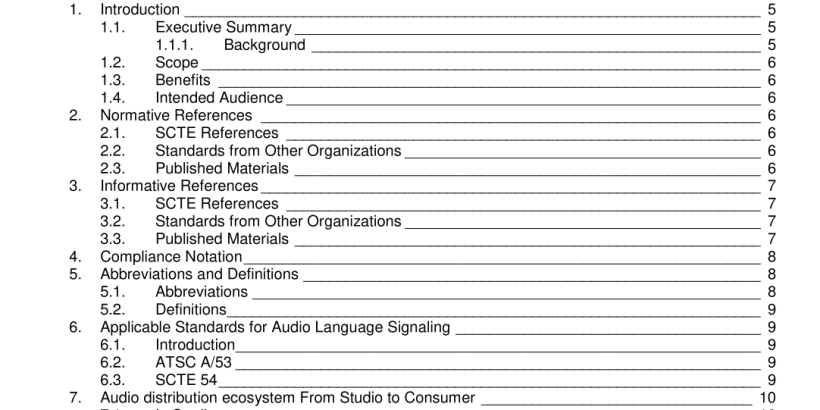ANSI SCTE 248-2018 pdf download.Operational Practice on Multiple Audio Signaling
7.3. Content Originator storage/playout
The arriving content is typically received in a digital format. This content goes through an ingest and quality assurance process to feed it and all the necessary metadata in to the media asset management system. The interoperable master format mentioned previously is aimed to help the ingest process and minimize additional quality assurance steps. Content originators typically store all of their content digitally and use a media asset management system to retrieve the content needed for playout. Content is usually “Ordered” from the playout or scheduling system and the various languages required for a particular airing are selected. The content is then transferred to a playout server and prepared for air. Most systems are designed for playing out a main and secondary audio and will require changes if they are to play out additional languages, VDS, or object based audio (e.g. Dolby ATMOS or MPEG-H). Some of the newer systems always deliver all possible audio streams to the playout server and allow the automation system to use what is available. Alternatively if certain tracks do not exist in the incoming content, sometimes the asset management system has rules to duplicate tracks. For example, if Spanish 2.0 is not present, then the system will copy the English 2.0 on to those tracks.
7.4. Content Originator to MVPD
Typically, the delivery of content from the programmer to MVPD is done using audio and video data compression (e.g. Dolby AC-3 and AVC) via satellite or terrestrial means. This is encapsulated in an MPEG-2 transport stream (TS) with individual program map table (PMT) for each program in the TS. Satellite delivery today uses a multiple program transport stream (MPTS). The MVPD usually decides what type of receiver is used in order to output the audio and video in the required format. Some typical outputs that MVPDs will require include; baseband audio and video, HD-SDI with embedded Audio; compressed audio/video that they use or transcode. An Integrated Receiver Transcoder (IRT) can also be used if the MVPD requires a video format that is different than the programmer delivers. With some programmers moving to HEVC this may be required for AVC in addition to MPEG2 video output. Some of the techniques that may assist with the transition to more audio streams would leverage a new version of IRT that can switch and/or transcode the audio as well as the video. Signaling of which audio to present on the decoded outputs would need to be present in the stream and some possible methods for signaling are in section 9.1. For VOD asset distribution a package is created with an SPTS audio/video file and various metadata files. The SPTS has static Packet Identifiers (PIDs) in a common format matching the Cablelabs CEP specification. The Main audio is on PID 0x1E1, SAP is on 0x1E2. Where extra audio streams exist beyond SAP on PID 0x1E2, the sequence simply continues (e.g., if VDS was available, that would be on 0x1E3). Some programmers are working on making their Adaptive Bit Rate (ABR) files available off of the origin server or content distribution network (CDN). These files are typically encrypted so the keys must be shared securely in order for an MVPD to use the same files.
Older but still widely deployed set top box architecture is based on a two audio only system with no capability to select a 3 rd audio, since the legacy set top does not support discovery of more than a pair of audio options. Some of the earliest digital set tops do not look at any descriptors and the first audio PID they find in the PMT is the main audio and the second is the SAP channel. The audio is delivered in a multi-audio channelization format with stereo or mono for the first audio and stereo or mono for the second audio channel. Currently, when VDS audio is required, the content of the SAP (e.g., ISO ‘spa’) channel is changed from an alternate language to the VDS track by the programmer, and the PMT, the version number, and descriptors are unchanged.ANSI SCTE 248-2018 pdf download
